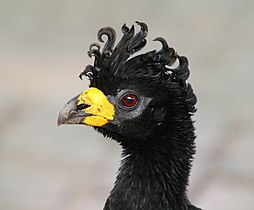Bare-faced curassow
| Bare-faced curassow | |
|---|---|

| |
| Male | |

| |
| Female Both in thePantanal,Brazil | |
| Scientific classification | |
| Domain: | Eukaryota |
| Kingdom: | Animalia |
| Phylum: | Chordata |
| Class: | Aves |
| Order: | Galliformes |
| Family: | Cracidae |
| Genus: | Crax |
| Species: | C. fasciolata
|
| Binomial name | |
| Crax fasciolata Spix,1825
| |

| |
Thebare-faced curassow(Crax fasciolata) is aspeciesofbirdin the familyCracidae,thechachalacas,guans,curassows,etc. It is found inBrazil,Paraguay,and easternBolivia,and extreme northeastArgentina,in thecerrado,pantanal,and the southeastern region of theAmazon basin.Its naturalhabitatsaresubtropical or tropical dry forestandsubtropical or tropical moist lowland forest.
Taxonomy
[edit]There are three currently recognizedsubspeciesfollowing the IOC,
- C. f. fasciolata(Spix, 1825) – fasciated curassow – lowlands ofBraziltoParaguayand northeastArgentina
- C. f. grayi(Ogilvie-Grant,1893) – easternBolivia
- C. f. pinima(Pelzeln,1870) – northeasternBrazil
Description
[edit]The bare-faced curassow is a large bird reaching a length of 82 to 92 centimetres (32 to 36 in). Thesexes differin appearance. The male has black upper parts faintly glossed with greenish-olive, with an unfeathered face with yellowish bare skin, a small black crest, and white underparts. The female, on the other hand, has a black head, throat, neck and upper mantle, and a black and white barred crest. The remainder of the upper parts are greenish-black barred with white or ochre. The black tail is tipped with white or ochre and the underparts are black with ochre barring on the breast, paling to a yellowish or ochre belly. The facial skin on females is blackish.[2]
Behaviour
[edit]The bare-faced curassow lives in moist, semi-deciduous and gallery forests, often near the fringes of the woodland. It mainly feeds on fruit, but seeds, flowers and smallinvertebratesare also eaten. Breeding takes place in the summer in the southern part of its range, with thenestsbeing platforms of sticks in trees.[1]
Status
[edit]The bare-faced curassow has a wide range and is fairly numerous in parts of its range; however, it is subject to hunting and to the destruction of its habitat and the total population is likely to be declining quite rapidly. TheInternational Union for Conservation of Naturehas assessed its conservation status as "vulnerable".[1]
References
[edit]- ^abcBirdLife International (2016)."Crax fasciolata".IUCN Red List of Threatened Species.2016:e.T45092100A95141387.doi:10.2305/IUCN.UK.2016-3.RLTS.T45092100A95141387.en.Retrieved16 November2021.
- ^Emmet Reid Blake (1 July 1977).Manual of Neotropical Birds.University of Chicago Press. p. 433.ISBN978-0-226-05641-8.
External links
[edit]- Bare-faced Curassow videos, photos and soundson the Internet Bird Collection
- Stamps[usurped](forParaguay) with RangeMap
- Bare-faced Curassow photo galleryVIREOPhoto-High Res--(Close-up)
- Photo-High Res;Articlechandra.as.utexas.edu–"Birds of Brazil"



